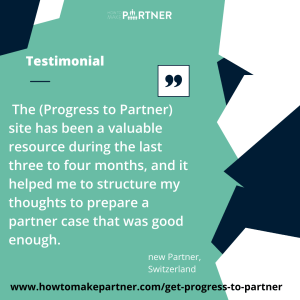A milestone of making partner is paying the new partner buy-in fee. However, with such a huge sum of money, this can be quite a nerve-wracking step (especially since it may require you to take out a mortgage-sized loan *gulp*). To help ease any worries when it comes to the buy-in process, here is everything you need to know.
Why are new partners required to buy-in to a firm?
Unless you are offered a salaried partner role, when you become a partner in a firm, you will also become a part owner of the firm. This means that you’ll be required to buy an equity stake, or as it is often known, ‘buy-in’ to their firm.
a
 How is a new partner buy-in amount calculated?
How is a new partner buy-in amount calculated?
A firm’s partnership agreement typically sets out the process to calculate a new partner’s buy-in amount. The new partner buy-in amount is typically based on a proportion of the firm’s accrual basis balance sheet. Nowadays, firms tend not to add a large goodwill factor to their buy-in calculations.
Start working on your own career progression. Why not sign up to receive my weekly tips here and you’ll find out what you need to be working on in your career development (and how to make the time for your career development) to progress your career all the way to partner in your firm.
How much is a typical new partner buy-in amount?
It is almost impossible to answer this question as it depends on several factors. For example:
- How well capitalised the firm is.
- The size of the firm relative to the number of equity partners.
- How the firm compensates partners.
I have to say that the typical new partner buy-in amount is not a publicly available figure. In fact, I was asked by an Australian journalist recently this very question. Unfortunately, her extensive research and my insider knowledge were not enough to properly answer this question!
 However, the 2021 Rosenberg survey of 400 American CPA firms found that the average buy-in for a new partner was $137,000. Years ago, the buy-in was determined by totalling the value of the firm (accrual basis capital PLUS the goodwill value of the firm) and then multiplying it by the ownership percentage awarded to the new partner. The result was often a HUGE figure for the buy-in (typically in the $400K-$700K range). As you can see from the results of the study, however, huge buy-ins are no longer the norm.
However, the 2021 Rosenberg survey of 400 American CPA firms found that the average buy-in for a new partner was $137,000. Years ago, the buy-in was determined by totalling the value of the firm (accrual basis capital PLUS the goodwill value of the firm) and then multiplying it by the ownership percentage awarded to the new partner. The result was often a HUGE figure for the buy-in (typically in the $400K-$700K range). As you can see from the results of the study, however, huge buy-ins are no longer the norm.
- Buy-ins range from $100,000 to $150,000, with the average being $144,000.
- Only 18 out of 400 participating firms reported buy-ins in excess of $400,000.
In the UK, I have heard of buy-in amounts ranging from £50,000 to £200,000. For example, my old firm, BDO LLP, used to have a new partner buy-in amount of £60,000. Whereas another top 10 UK accountancy firm (and not a Big 4 firm) has a fixed amount for a new partner buy-in of £100,000.
Insider tip: some firms disguise the true buy-in amount!
For example, some firms require new partners to pay $20,000 immediately upon becoming partner. The remainder is then paid over a period of years via payroll deductions until the partners deem that it has been a “sufficient amount” based on vague factors like ‘level of performance.’ When these firms respond to MAP surveys, they state $20,000 as their partner buy-in amount, when the true value lies between $200K – $300K!
Other firms state zero as their partner buy-in amount! While there may not be an upfront payment, payroll reductions are still paid until the partner’s capital account equals their annual compensation, usually $200-$300K.
How do new partners finance their buy-in?
Whatever your firm’s new partner buy-in amount, most of us usually don’t have enough personal funds to cover this. In the UK, most firms will help their new partners to get a partnership loan to buy their stake in the firm. The firm will then guarantee the loan. Your drawings will then be used to pay off the interest on the loan and sometimes a portion of the capital.
I know of many new partners who are initially very concerned about taking out a mortgage-sized loan to buy an equity stake in their firm. However, the reality is that if your firm’s balance sheet is healthy and the firm is well led and managed, this partnership loan is very low risk. This is why I say that it’s vital that you do your due diligence on your firm BEFORE signing the partnership agreement.
In the U.S…
Some firms, particularly in the USA, will not require their new partners to inject capital on the day they join. Instead, the firm gradually pays their ‘buy-in’ amount by withholding a proportion of the new partner’s profit share. They do this until you’ve paid off their buy-in amount.
Start working on your own career progression. Why not sign up to receive my weekly tips here and you’ll find out what you need to be working on in your career development (and how to make the time for your career development) to progress your career in your firm.
a
How much do Big 4 partners really make?
 In our post on how much do Big 4 partners earn in the UK, we identified from publicly available information that the average partner drawings for a Big 4 partner in the UK is going to be over £500k.
In our post on how much do Big 4 partners earn in the UK, we identified from publicly available information that the average partner drawings for a Big 4 partner in the UK is going to be over £500k.
However, before you mentally start salivating over that level of salary or drawings (as it is), remember: this is the average figure! This means that for every partner who earns over £500k, there will be a partner who earns under £500k.
The partners in the top two quartiles for their average earnings will normally be:
- Senior equity partners who have built up a hefty client portfolio and network of introducers.
- In an advisory rather than assurance or compliance-based function.
One of our most sought-after courses in our subscriber-only site Progress to Partner is called “How to Build a Cast-Iron Business Case for Partner”. We think it’s a must-have in your arsenal of tools and guidance to help with your career progression. There is also a section on the Partnership Admissions process with guides and recordings to help you find your way through the system. Check it out!
Read more about Big 4 partner salaries.
a
Is the skills shortage affecting partner buy-in?
In a nutshell, yes. The talent shortage, skills shortage, succession crisis, whatever you want to call it, is also greatly affecting the law and finance industries. With there being a shortage of potential partners, we can only assume that firms will have to start trying to make it easier to become partner (i.e. by decreasing buy-in amounts and making terms more favourable).
Read more: What size of client portfolio will I need to make partner?
a
What does it really mean to make partner?
 It’s a vigorously exhausting and mentally challenging process to become partner. Depending on the firm, it could even take up to 10 years! As you can imagine, it would be quite devastating to make partner only to realise that it’s not what you thought it would be, so you need to know what it takes to get there and what it is actually like being a partner before deciding to commit to the journey.
It’s a vigorously exhausting and mentally challenging process to become partner. Depending on the firm, it could even take up to 10 years! As you can imagine, it would be quite devastating to make partner only to realise that it’s not what you thought it would be, so you need to know what it takes to get there and what it is actually like being a partner before deciding to commit to the journey.
Yes, making partner is a massive achievement and with it comes status and reward. However, the responsibility is high now as you become an owner of the firm which can mean long hours and not making any money at all if your firm struggles to make a profit.
One of our most sought-after courses in our subscriber-only site Progress to Partner is called “How to Build a Cast-Iron Business Case for Partner”. We think it’s a must-have in your arsenal of tools and guidance to help with your career progression. There is also a section on the Partnership Admissions process with guides and recordings to help you find your way through the system. Check it out!
- What does it really mean to make partner? You may be surprised!
- Making partner- the pros and cons. Do you really want to make partner?
- What changes when you make partner and how to prepare for them
- I want to make partner. Where do I start?
What’s included in the FREE guide:
 1. Extracts from real and successful business cases for partnership
1. Extracts from real and successful business cases for partnership
2. How to structure your business case for maximum impact
3. What questions your business case needs to answer
Click here and we’ll send your FREE guide to creating your business case for partnership
Free guides and templates to get you through your firm’s partner track process
An idea of the size of client portfolio you will need to be a partner in a Big 4 firm
What due diligence should I do on my firm before buying in
6 tried and tested tips to ace your Partner Panel Interview
The definitive guide to building a business case for partnership








